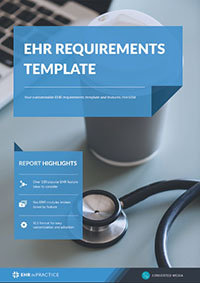EHR requirements and key features: your complete guide
The process of mapping out your practice’s EHR requirements is essential to a successful selection project. Without a rigorous EHR requirements gathering process the process will suffer due to a lack of direction and focus.
Think of determining your practice’s EHR requirements like planning a vacation - you need to decide what you would like to get out of it (a chance to unwind), and what a particular destination would need to have to help you achieve this (nice countryside, good weather, well-regarded local cuisine).
EHR requirements gathering requires a similar thought pattern - if your main goal is to increase patient throughput, you need to map out the key features (patient portal, scheduling, e-prescribing) that will help you achieve that.
A successful requirements gathering process can be distilled down to three key elements:
- Clear, objective, and measurable goals.
- Understanding of how an EHR will contribute to your practice’s goals.
- Subsequent knowledge of which EHR features best compliment achieving your practice’s goals.
Basically, if you lack a clear direction and understanding in the requirements gathering process which can translate to problems in the selection process a practice, risks any number of negative consequences which can ultimately result in lost revenue, unnecessary costs, and a diminished ability to deliver quality care.
This guide will cover:
- What requirements gathering is and how you should carry it out
- The importance of requirements gathering in the EHR selection process
- The core features an EHR should posses
- The role Meaningful Use requirements occupy in requirements gathering
- Advanced, specialty and general EHR features
Gathering your EHR requirements. Why? How?
To figure out what you want from a new EHR, you have to be systematic.
Put simply, requirements gathering is similar to creating a grocery list. Instead of a list containing items from the supermarket to make certain meals, an organization engaged in requirements gathering is generating a list of specific EHR software features that would assist a practice in meeting its strategic goals.
Why create a set of EHR requirements?
Prior to investing in EHR, a practice should understand how this technology can be leveraged to achieve a practice’s strategic goals.
Without a clear idea of practice has EHR hardware and software requirements one is simply wandering aimlessly. As such
“a poor requirements gathering phase means you could waste money by choosing an inadequate system and risk losing excellent clinicians because of poor operations. In the end, patient care could suffer.”
In the context of creating an EHR selection criteria it is important to create an EHR features list containing products whose features best compliment strategic goals, the requirements gathering process provides the foundation of the selection process. Without a well planned and executed requirements gathering process the EHR selection process will suffer and can in some cases result in a practice selecting an EHR that is not a good fit.
How do I map out my practice's EHR requirements?
It is important to understand requirements gathering as a process involving collecting information from key stakeholders and then determining what a practice considers key capabilities of an electronic health record system.
In other words, EHR features that would best help a practice meet its strategic goals. This process involves three main actionable steps:
- Define your practice’s goals. What do you hope to achieve by implementing a new EHR? Where is your existing software letting you down? What are your future practice needs, and how will replacing your EHR now place you in a position to meet them?
- Consult your key stakeholders to build an extensive list of requirements and understand key user needs. Remember: you may not be able to give your practice staff every single feature they want - best to manage expectations here rather than giving everyone a blank slate to dream up their wildest EHR unicorns, only to end up disappointed.
- Determining requirements and needs using an objective criterion. Using this approach requirements are determined by using a ranking system that assigns a numerical value to each function or usability characteristic identified as important on a scale of 1 to 5 with 1 representing the lowest priority and 5 representing the highest priority.
- Prioritizing requirements after data collection should be conducted to create a refined list that ranks the most essential requirements at the top of the list and less pressing requirements lower on then list.
- Combine and document EHR software requirements and EHR hardware requirements data in an EHR functional requirements document after it has been validated as accurately representing the needs of stakeholders.
Core EHR features to help you meet practice requirements
A logical starting point for determining what EHR features a practice requires involves gaining an understanding of core EHR features and what they do.
The EHRs on the market today generally share a set of key features that are standard regardless of the setting in which the system will be used.
However, when one moves beyond these core features the functionality available varies depending on an EHR’s practical application and the sophistication of the system.
The Institute of Medicine (IOM) has identified what it considers 'Key capabilities of an electronic health record yystem', or a set of eight core functions of EHR systems should be capable of performing. These are:
- Health information and data: storing clinical information and data in an electronic format that can be retrieved and viewed efficiently.
- Result management: the ability to manage test results.
- Order management: electronic processing of orders and prescriptions.
- Decision support: warn providers of possible risk and provide information to aid in clinical decisionmaking.
- Electronic communication and connectivity: communicate and connect with other providers across multiple care settings.
- Patient support: provide patients with information and allow patients to communicate with their provider.
- Administrative processes and reporting: practice management functionality such as billing and scheduling, among others.
- Reporting and population health: produce and share reports on clinical data concerning patient population health.
These core features should be treated as a baseline for when deciding on the functions of EHR system. However, practices will likely require features that offer more sophisticated versions of these core functions. For example, practices may require more advanced practice management features such as the ability to analyze revenue trends or management supply orders. Further, more advanced features beyond simple data collection and reporting such as predictive modelling of patients who display a high risk of developing a chronic illness or at risk of readmission during recovery.
What are the requirements for EHR incentives?
Obtaining EHR incentives is a key consideration for many practices, due to the fact incentive payments provide a much-needed way to offset the capital investment costs in EHR technology. Eligible professionals can receive incentive payments through the Meaningful Use program administered by CMS, which provides a financial incentive to adopt EHR technology.
Under the program eligible professionals and hospitals must adopt certified EHR technology, or an EHR that displays the required EHR software requirements, and use it to achieve specific objectives within their practice to receive incentive payments.
The 2017 Meaningful Use requirements consist of three stages:
- Stage 1 which represents attesting to the most basic EHR functionality generally involving just the electronic capture of clinical data and providing patients with electronic copies of health information.
- Stage 2 represents the expansion of Stage 1 criteria focusing on advancing clinical processes through using EHRs to enhance quality improvement at the point of care and the exchange of information in the most structured format possible.
- Stage 3 focuses on using EHRs to improve health outcomes.
Eligible professionals who want to continue to receive incentive payments will likely tailor their requirements gathering process toward creating a list of functions of an EHR system that will allow a practice to attest to meaningful use and thus receive incentive payments. For example attestation to Stage 3 requires practices to focus more heavily in patient engagement and population health data collection, as such a features list would feature EHR functionality that meet these goals.
Advanced and specialty EHR features
A practice’s EHR performance requirements will also be guided by whether they require advanced features such as practice management software and whether the practice is a general or specialty practice. General purpose EHR products, as the name implies contain core features that can be used in a general practice setting or can be customized to be used in a specialty practice. Specialty practices using a general EHR often customize the data entry fields entry to accommodate the type of data specialty practices collect. Specialty EHRs, as opposed to general EHRs, are designed specifically for a specialty practice. For example, an oncology specific EHR will have data entry fields designed for the type of testing, diagnostic and treatment data collected in oncology practice, and will not require any type of customization.
EHR and practice management software
EHRs generally deal with clinical data and records whereas practice management systems offer a software solution that automates many of the day-to-day administrative work conducted in healthcare, such as billing, patient outreach, scheduling and time management. In recent years the functional difference between EHR and practice management products has become more blurred as these products have integrated. In this shift, practice management systems rely more heavily on clinical data collected by an EHR and vice versa. The greater integration between these systems has offered practices more nuanced and comprehensive data on which to base their decision making.
The primary difference between EHRs and practice management systems is not in how the software functions from a general perspective, as EHRs and practice management solutions are offered as an integrated suite so that data can be shared between the two systems. However, EHRs are mainly concerned with clinical tasks whereas practice management enables practices to provide better clinical care through making the administrative side of a practice more efficient.
Specialty vs general EHR features
The EHR market has developed to a point where a specialty practice can choose between a variety of general and specialty EHRs.
Currently, a number of EHRs offer features that are flexible in nature so that they can be adapted to meet the needs of specialty practices.
For example, templates for data input fields can be modified to meet the needs of specialty practices or workflows can be modified with little effort to accommodate varying types of practices.
However, certain specialties often benefit from specialty EHRs that do not require modification. These can be delivered with specialty-practice focused features that offer greater functionality than their general practice EHR-counterparts such as behavioral health, pediatrics, dentistry, and oncology.
In these specialty-focused EHRs, the system is structured in a way that takes into account the unique nature of these specialty practices and offers a specialized product that can offer advantages that a general EHR is unable to offer.
An example of this specialization is found in physical therapy EHRs that provide integrated physical therapy specific forms and the ability to manage testing and performance data.
Similar specialized features are found in oncology EHRs which provide features that cater to data intensive nature of oncology practices such as managing data generated from testing and the administration of chemotherapy.
Aligning a practices’ requirements and the key features available on the market forms the foundation of successful selection process. The main driver of an effective selection process is a rigorous requirement gathering process. Without this vital element the selection process will suffer due to a lack of direction and focus. With a focused and rigorous requirement gathering process the chances of selecting the right EHR product can be increased greatly.
Potential problems with EHR selection
Research conducted by the Stanford School of Medicine, in conjunction with the Harris Polling Firm, provides insight into some of the perceived shortfalls medical providers see in EHR features and functionality. According to the survey almost two-thirds of the primary care providers surveyed think EHRs have generally led to improved care while 66% are at least somewhat satisfied with their current EHR system. (66%). Despite many providers who have a positive outlook a large segment still indicates significant problems with their EHR with 40% of respondents indicating EHRs present more challenges than benefits with 49% indicating their EHR detracts from their clinical effectiveness.
When considering the survey results presented above, a great deal of the discontent could be chalked up to overall negative attitudes toward EHR technology, in this sense one can assume that regardless of improvements in EHR technology there will always be lingering negative attitudes toward EHR performance. However, a great deal of the problems medical providers cite regarding their EHR can be addressed by doing as better job aligning practice requirements and EHR features. The most effective way to align practice requirements and EHR features available on products in the market involves a robust and requirements gathering process.
Free white paper

50 features to look for in your next EHR
A comprehensive guide to EHR features and how they can benefit your practice

Featured white papers
Related articles
-

What are the core functions of EHR
The basic functionality that your EHR should include
-

What successful EHR requirements gathering looks like
How to get the most out of your EHR requirements gathering process
-

The most important EHR features for practice management
The key functionalities any practice management software should have



